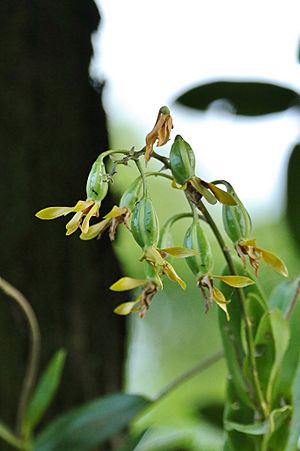Dark-stemmed antler orchid facts for kids
Quick facts for kids Dark-stemmed antler orchid |
|
|---|---|
 |
|
| In Palau | |
| Conservation status | |
| Scientific classification | |
| Genus: |
Dendrobium
|
| Species: |
mirbelianum
|
| Synonyms | |
|
|
The dark-stemmed antler orchid, also known as the mangrove orchid, is a special type of orchid. Its scientific name is Dendrobium mirbelianum. This orchid grows on other plants, like trees (it's an epiphyte), or sometimes on rocks (it's a lithophyte). It has dark, round stems and leathery green leaves. Its flowers are usually pale to dark brown with a yellow center that has red lines. You can find this orchid in northern Australia, New Guinea, and Indonesia.
Contents
What the Dark-Stemmed Antler Orchid Looks Like
The dark-stemmed antler orchid is a plant that grows on other plants or rocks. It has dark, blackish-brown stems called pseudobulbs. These pseudobulbs are like thick, round storage stems. They can be from 0.2 to 1.0 meter (about 8 inches to 3 feet) long. They are about 20 to 30 millimeters (about 1 inch) wide. The upper part of the stem has many leaves.
The leaves are dark green, sometimes with hints of brown or dark red. They are about 80 to 150 millimeters (3 to 6 inches) long. They are also 30 to 40 millimeters (1 to 1.5 inches) wide.
Flowers of the Antler Orchid
The orchid's flowering stem grows to be 100 to 300 millimeters (4 to 12 inches) long. This stem holds between four and twelve flowers. Each flower is 25 to 35 millimeters (1 to 1.4 inches) long. They are also 30 to 40 millimeters (1.2 to 1.6 inches) wide. The flowers can be pale to dark brown.
The outer parts of the flower are called sepals and petals. These can sometimes be twisted. They are 25 to 30 millimeters (1 to 1.2 inches) long. They are also 7 to 9 millimeters (0.3 inches) wide.
The special lip of the flower is called the labellum. It is yellow with red veins. The labellum is about 30 millimeters (1.2 inches) long and 20 millimeters (0.8 inches) wide. It has three main parts, called lobes. The side lobes curve upwards. The middle lobe has wavy edges. It also has three small ridges down its middle.
When the Orchid Flowers
This orchid mostly flowers from August to November. However, you might see flowers at other times of the year too. Some plants have flowers that open wide. These flowers are pollinated by insects. Other plants have flowers that open very slowly, or not at all. These flowers can pollinate themselves. This is called self-pollination.
How the Orchid Got Its Name
The Dendrobium mirbelianum orchid was first officially described in 1829. This was done by a French botanist named Charles Gaudichaud-Beaupré. He wrote about it in his book, Voyage Autour du Monde.
The second part of the orchid's scientific name, mirbelianum, honors someone special. It is named after Charles-François Brisseau de Mirbel. He was a French botanist and a politician.
Where the Dark-Stemmed Antler Orchid Lives
The dark-stemmed antler orchid grows in trees, especially in mangrove forests. It also grows in coastal swamps. Sometimes, you can find it growing on rocks.
You can find this orchid in several places:
- The Maluku Islands in Indonesia.
- New Guinea, including the Bismarck Archipelago.
- The Solomon Islands.
- Moa Island in Australia.
- Between the Daintree and Innisfail in Queensland, Australia.
Protecting This Special Orchid
This dark-stemmed antler orchid is considered "endangered." This means it is at a high risk of disappearing forever. Both the Australian Government and the Queensland Government have laws to protect it. These laws are the Environment Protection and Biodiversity Conservation Act 1999 and the Nature Conservation Act 1992.
The biggest danger to this orchid is when land is cleared. People clear land to make space for farming. This destroys the places where the orchid naturally grows.


